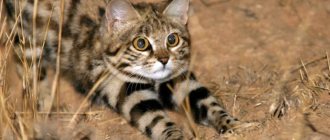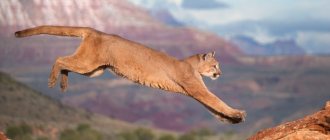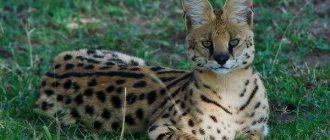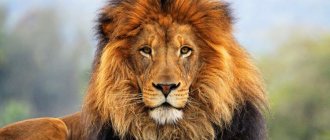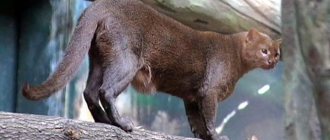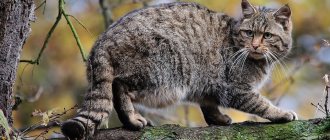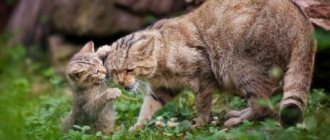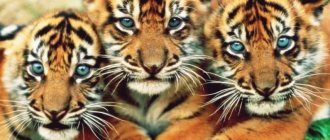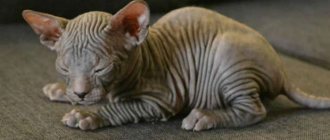The European forest cat is not a breed, much less a feral specimen of a domestic pet. This is exactly the type of cat from which, apparently, most of the natural breeds of cats known to mankind originated.
Wild European cats can be found in many zoos around the world. At first glance, these animals are no different from domestic cats. Moreover, in fact, these are dangerous and intelligent predators that are adapted to live only in natural conditions.
History of the species
Scientists believe that the Forest Cat appeared in the Pleistocene era, which began more than 2.5 billion years ago and ended 11.7 million years ago. Considering that humanity is only 2.8 billion years old, wild cats are at least 9 years older than humans.
The end of the Pleistocene era is characterized by an incredibly harsh climate. The planet had just experienced an ice age, the ice masses were retreating reluctantly, weather conditions also changed in waves - periods of sharp warming alternated with periods of the onset of very cold air masses. These processes served as an impetus for the transformation of flora and fauna. It was at this time that the woolly rhinoceros, mammoth, giant deer, cave lion and many other species appeared, most fully adapted to harsh climatic conditions.
With subsequent global warming, most animals of the glacial and post-glacial periods were unable to mutate and became extinct. The cat, which went into the shady forests and mountain ranges, managed to survive.
Thus, we can only talk about the approximate, latest date of the emergence of the European forest cat as a species - 11.7 million years ago. Although, most likely, this animal is older and has survived to this day since the Ice Age without any special changes.
The domestication of cats occurred much later, about 10 thousand years ago, when people began to lead a sedentary lifestyle, build homes, develop agricultural land and stockpile food.
Mr. Cat recommends: characteristics
The Central European forest cat, Felis silvestris silvestris or European Wildcat, is a predatory mammal of the cat family. The Latin name for Forest Cats can be roughly translated as “a wild cat living in the forest.” They live on almost the entire planet, namely in Europe, Asia and Africa (steppe species are distinguished there). To learn more about the classification and understand it, read the article about Steppe cats. This article will focus only on those wild Forest cats that have acclimatized on European territory.
This is a small animal, which is still larger than an ordinary domestic cat, although it is very similar to it in its general structure:
- The body is quite long, elongated, muscular.
- Male individuals are from 45 to 93 cm in length, weigh 6-9 kg; females from 39 to 78 cm and 4-7 kg.
- The limbs are of medium length with sharp claws that can be hidden in the fingertips. They are well adapted for climbing trees and rocks, hunting and protecting themselves from enemies.
- The hind legs are somewhat longer and more powerful than the front legs. They help the animal make high jumps.
- The tail is of sufficient length (from 18 to 41 cm), usually slightly larger than the size of the body. Wide at the base and slightly tapering further, but its tip is not pointed, but rounded.
- Large head with developed wide cheekbones. The jaw is short and blunt. European forest cats have a larger cranial volume than domestic cats, a ratio known as the Schauenberg index.
- The ears are medium in size (5-7 cm), widely spaced, without tufts at the tips, but with inner feathering.
- The vibrissae are voluminous, thick, and white. Near the mouth there are 8-18 of them on each side, 5 to 8 cm long, near the eyes there are fewer of them - 7-8 and they are shorter (5-6 cm). But they are also on the inside of the hand, this is a group of 3-6 hairs 4-5 cm long.
- The eyes are large and widely spaced, with a slit-like vertical pupil. The iris is colored yellowish, greenish or emerald-golden.
- The lobe is flat, large, brick-colored.
- The coat is of uniform medium length throughout the body, it is much longer on the tail, making it appear large and fluffy.
- The undercoat is thick and voluminous. Because of it, the animal is perceived as much larger.
- Color in grayish tones. There are patterned lines on the head, back, sides, and tail. There are usually four clear lines on the back of the skull.
- The tail is surrounded by black rings, from three to ten.
- Summer fur after molting is much lighter, without ocher and brownish impurities, sometimes ashy.
- They usually have four pairs of nipples: two on the chest and two on the belly.
- The chromosome set includes 38 diploids.
European wild cats mainly live in deciduous and mixed forests, where there are no human settlements. Populations are also found on coasts and in coastal forests, near wetlands, and on hills. Avoid high mountain areas, snow-covered areas with a high thickness of cover.
The Central European forest cat is much larger than its wild relatives from the steppes. There are even males weighing 14-16 kg. The closest relatives of these animals are swamp lynxes and manulas.
Appearance
The Amur forest cat is only slightly larger in body size than domestic cats. The entire adult male usually does not exceed 6-8 kg, especially large specimens can weigh up to 15 kg. Females are more graceful and noticeably smaller.
- The body length of a wild cat can reach 90 cm, with at least 1/3 of it being the tail. The average tail length of the individuals that naturalists were able to measure is 35-37 cm.
- The body of the Far Eastern wild cat is elongated, strong and well-built.
- The head is small compared to the body, the tail is thin and long.
- The ears are small, widely set, slightly tilted forward, which is typical for many felines, and there are no tassels at the ends.
- The eyes, on the contrary, are large and expressive, located close to each other.
- The nose is wide, flat with a brown nose. The vibrissae pads are well defined and complement a strong and rounded chin.
Although the Far Eastern cat is similar to domestic tabby cats, few of them can boast such a fluffy and warm coat. The fibers of its dense fur can reach a length of 5 cm.
Color of Far Eastern cats
The smallest among Asian cats, they have a protective coloring that makes them almost invisible among trees and shrubs. The upper part of the body is darker, the basic tone can vary from grayish-yellow to gray-brown.
Along the ridge there are 3 longitudinal stripes of brown color, formed by the merging of narrow spots. In some individuals these stripes merge into one wide one. The throat under the chin is decorated with 4-5 transverse stripes of reddish-brown color.
There are clear stripes on both the forelimbs and the muzzle. The thin and elegant tail is usually colored in a single color in reddish or black-gray, but there are also contrasting rings in black or gray.
Dark red spots, blurry or clearly defined, are scattered throughout the body. In the abdomen and groin area they are lighter.
This coat color is reminiscent of ancient Chinese coins, which is why in the Celestial Empire Amur forest cats are called “money cats.”
Varieties of Wild Forest Cat
The wild forest cat includes 23 subspecies, including, in particular:
- Central European Felis silvestris silvestris;
- Caucasian Felis silvestris caucasica;
- Turkestan Felis silvestris caudata;
- Omani Felis silvestris gordoni;
- Steppe Felis silvestris lybica;
- African subspecies Felis silvestris cafra;
- Chinese Felis silvestris chutuchta;
- Domestic Felis silvestris catus.
Habitat of the European Forest Cat
Most populations of European forest cats live in the west and center of the continent - in Western Ukraine, Moldova, Slovakia, the Carpathians and Transcarpathia. A subspecies, the giant Iberian cat, also lives on the Iberian Peninsula.
The European cat is also found in the Caucasus, where it is adjacent to Felis silvestris caucasica. A fairly large part of them have lived in Scotland since ancient times, but now they are under threat of extinction due to widespread interbreeding with domestic cats.
The Ukrainian population lives mainly in broad-leaved hornbeam-oak, beech and other mixed forests. The Moldavian also chose beech forests for its habitat, but is also found in floodplains. These are dense thickets of tallow and reeds with rare hollow willows and sedges.
The European part of Russia, Germany, southern Spain, Italy are also among the places where the European forest cat lives.
These animals are able to live at an altitude of 2-3 thousand meters above sea level. Their thick coat with a warm undercoat can withstand large temperature changes, heat, high humidity and frost.
Between the late 17th and mid-20th centuries, the cat's habitat became fragmented due to large-scale hunting and regional extermination. The animal may have completely disappeared in the Czech Republic and is considered regionally extinct in Austria, although stray individuals from Italy still migrate there. The species has never inhabited Scandinavia, and Sicily is the only island with a population of these animals living there.
Notes
- ↑ 1 2 Aristov A. A., Baryshnikov G. F.
Mammals of the fauna of Russia and adjacent territories. Predatory and pinnipeds (In the series: Guides to the fauna of Russia, published by the Zoological Institute of the Russian Academy of Sciences. Issue 169). - St. Petersburg, 2001. - P. 403. - 560 p. - Flint V. E.
,
Chugunov Yu. D.
,
Smirin V. M.
Mammals of the USSR / Ed. A. N. Formozova. - M.: Mysl, 1965. - P. 129-151. — 438 p. - Life of animals. Volume 7. Mammals / ed. V. E. Sokolova. — 2nd ed. - M.: Education, 1989. - P. 316. - 558 p. — ISBN 5-09-001434-5
- Sokolov V. E.
Five-language dictionary of animal names. Mammals. Latin, Russian, English, German, French. / under the general editorship of academician. V. E. Sokolova. - M.: Rus. lang., 1984. - P. 108. - 10,000 copies. - Driscoll, C. A., et al. (28 June 2007). "The Near Eastern Origin of Cat Domestication". Science 317
(5837):519–523. DOI:10.1126/science.1139518. PMID 17600185. - Driscoll CA, Menotti-Raymond M., Roca AL, Hupe K., Johnson WE, Geffen E., Harley EH, Delibes M., Pontier D., Kitchener AC, Yamaguchi N., O'brien SJ, Macdonald DW The
Near Eastern origin of cat domestication // Science. - 2007. - T. 317 (5837). - pp. 519-523. - Felis silvestris
Archived August 13, 2011 on the Wayback Machine // Wilson DE & Reeder DM (editors). 2005. Mammal Species of the World. A Taxonomic and Geographic Reference (3rd ed.). — Baltimore: Johns Hopkins University Press, 2 vols. (2142 pp.) ISBN 978-0-8018-8221-0 [1] - Systematic list of vertebrates in zoological collections as of 01/01/2012 // Andreeva T. F., Vershinina T. A., Goretskaya M. Ya., Karpov N. V., Kuzmina L. V., Ostapenko V. A., Sheveleva V.P. Information collection of the Euro-Asian Regional Association of Zoos and Aquariums. Issue No. 31. Volume II. Interdepartmental collection. scientific and scientific method. tr. / Ed. V. V. Spitsina. - M.: Moscow Zoo, 2012. - P. 443. - 570 p. ISBN 978-5-904012-37-3 PDF Archived May 24, 2013.
Features of behavior
European forest cats are very careful, they can even be called shy. This often leads to manifestations of aggression towards strangers. These cats especially avoid human settlements and try not to be seen by people at all. In general, they prefer not to enter into conflicts with their relatives or with any other predators.
They live alone. An adult male is able to control a forest area of up to three square kilometers. To mark boundaries, the cat leaves marks from physiological secretions and claw marks on tree trunks. Therefore, strangers rarely wander into its territory.
The European forest cat has many natural enemies - lynx (Lynx), large steppe cat, jungle cat (Felis chaus), fox (Vulpes Vulpes), gray wolf (Canis lupus), jackal (Canis aureus), marten (Martes martes), bear (Ursus arctos). In Tajikistan, the wolf is the most serious competitor for the Forest cat; quite frequent destruction of cat holes is observed here. Birds of prey, including the Eurasian eagle owl (Bubo bubo) and saker falcon (Falco cherrug), are often quite successful at preying on cat kittens. Naturalist Seton Gordon recorded an incident where a Forest cat fought with a golden eagle (Aquila chrysaetos), resulting in the death of both parties.
The animal spends most of the daytime in a den, most often built in an old hollow in a large tree. Tree hollows usually contain enough sawdust, so the cat does not make additional bedding. If fleas appear in the den, the Steppe cat moves to another place. In winter, when snowfall prevents the cat from traveling long distances, it remains in its shelter until the climatic conditions for movement improve.
Those individuals that live in the mountains make rookeries in rock crevices or abandoned burrows of badgers (Meles meles) and foxes (Vulpes Vulpes). They are small depressions under cliffs, dense accumulations of branches; for Wild cats this is not only a den, but also a temporary shelter in times of danger.
Crevices in rocks or holes, equipped as shelters, are lined with dry grasses and bird feathers.
In the floodplains, animals choose wide forks of trees and abandoned nests of large birds, such as herons, for shelter and resting places.
The predator goes out for prey at night, several hours before dawn. But in winter conditions it practices additional hunting early in the morning and late in the evening.
European forest cats living in floodplains control up to one or two hectares of territory, but during the mating season, males can leave the boundaries of their territory in search of females.
The European forest cat is capable of moving very quickly when pursuing prey or escaping from pursuit, and is an excellent climber of trees and low rocks.
The animal has excellent hearing and vision, and a slightly lower level of smell. It is silent, but capable of making low and hoarse meowing sounds, and can purr, snort, purr, and hiss.
Due to the large number of enemies in the forest, from which, however, the predator is able to instantly hide in trees and rock crevices, the appearance of the beast is associated with a gloomy and wary creature. Nevertheless, this is one of the most beautiful and noble animals in the world, somewhat reminiscent of an exotic domestic cat.
Wild spotted cats
Spotted coats are worn by both the largest species of the cat family and the smallest wild cats, which do not exceed the size of domestic cats. This color helps animals camouflage themselves - both when hiding in ambush for hunting, and when hiding from stronger enemies, so as not to become their victim.
Photo gallery: spotted species of wild cats
Jaguar is one of the three largest cats on the planet
The leopard population size can be surpassed by any member of the cat family
The small black-footed cat is a cruel and bloodthirsty predator
The Far Eastern cat eats a lot and sleeps a lot, and in between it hunts a lot
The spotted-striped reed cat settles in fox holes or builds huts from reeds
Oncilla - the name of this rare cat translates as “little leopard”
The extraordinary beauty of the snow leopard led to the almost complete extermination of this species
Geoffroy's little cat is one of the rarest and most beautiful
It is precisely its bright spotting that distinguishes the red lynx from the common lynx.
The Iriomote cat lives only on the island of Iriomote
The Far Eastern leopard is a rare, secretive animal.
It’s impossible to tame the cute, fluffy Pallas’ cat
A wild Bengal cat has passed on its beauty to its domestic cat
The ocelot is quite well tamed and gives birth to domestic cats.
Jaguar or leopard?
The largest and most dangerous spotted cats - the jaguar and the leopard, at first glance, are very similar to each other. But these are completely different species, and the animals have significant differences, although they belong to the same genus. The leopard's habitat is South Asia and almost all of Africa, with the exception of the Sahara. Jaguars are distributed throughout South and Southern North America.
The jaguar is more powerful and massive than the more elegant leopard. A large male jaguar can weigh up to one and a half centners, which does not prevent him from moving rapidly, making giant leaps and masterfully climbing trees. These predators allow themselves to hunt large and strong animals - even alligators sometimes become their prey.
Jaguar is the largest spotted cat
Leopards are also one of the most successful hunters among felines. The survival rate of the species, which is often called the panther (by its generic name), is very high. He is not picky about food, and on occasion he will not disdain carrion. A male leopard usually does not weigh more than 75 kilograms.
The vast territory and different living conditions have formed several varieties within the species, which, among other things, differ in the colors of their famous fur coat. Depending on the places in which the leopard lives and hunts, the main tone of its fur can be bright orange, light yellow or grayish, almost silver.
Leopard is the most common spotted cat
Actually, the fur patterns of jaguars and leopards themselves are different. The jaguar's black spots are larger and more contrasting - they are irregular rings with black dots inside. The leopard's spots are small, round or almost square, they are located separately or collected in the likeness of flowers (rosettes).
Jaguar (left) and leopard (right) are brothers, but not twins
Video: fur pattern is the main difference between a jaguar and a leopard
Snow Leopard
According to the most optimistic estimates, the number of this beautiful animal does not exceed seven thousand adult individuals. The snow leopard, also known as the snow leopard, is listed in the International Red Book and has become a participant in various programs for the conservation and breeding of rare species. Only thanks to the active participation of the world community in its fate, the snow leopard still survived as a species - its valuable fur was too attractive for poachers.
The snow leopard is a beautiful rare cat listed in the Red Book
In the wild, these cats do not survive longer than 13 years. In captivity, their life expectancy can increase significantly - the record holder was the snow leopard, who lived in the zoo for up to 28 years.
The harsh living conditions have formed the snow leopard's unique fur, the likes of which no other cat has - thick, densely “stuffed” with undercoat and very long, up to five centimeters. Contrasting black spots look especially impressive on a light gray, almost white background.
Snow leopards diligently avoid meetings, but when they meet, they fight to the death
Cheetah
The main thing we know about cheetahs is that they are unsurpassed runners. Indeed, in pursuit of prey, these feline sprinters can accelerate to almost a hundred kilometers per hour - but they do not maintain this speed for very long. A running, flying cheetah is a stunning sight: the structure of the animal’s body, its muscles are perfect and ideally adapted to the chase.
Even the quality of the fur is adapted to the most important task - to catch up and catch. The hairline is almost devoid of undercoat, but consists mainly of a smooth elastic spine, which, when running tightly to the body, makes it even more streamlined. Cheetahs take great care of their beautiful fur.
It is interesting that in nature there are different color variations of the color of these animals: sometimes there are albinos and melanists, even red individuals (dark red spots on a golden background), and in the desert cheetahs live in a very faded, non-contrasting color. The so-called royal cheetah stands apart - the result of a genetic mutation - with very large bright spots and stripes along the spine.
The king cheetah was previously considered a separate species - a hybrid with the serval
Cheetahs do not show aggression towards humans, and in some cases they are even quite well tamed. A thousand years ago in Persia, trained cheetahs were used to hunt saigas. Such animals were called pardus; they were incredibly expensive and were available only to the highest nobility.
In the Republic of South Africa, an adult female cheetah named Jolie has been living with a human family since early childhood. She behaves like an ordinary cat, docile and affectionate. Even better - Jolie travels with the owners, knows many commands, and is friends with the owner's dogs and cat.
Jolie and friends pose on the master's bed
Video: cheetah is the fastest animal on the planet
Fishing cat
The fishing cat, or civet fishing cat, prefers to settle along the banks of small bodies of water in the tropical or subtropical forests of Southeast Asia. In appearance, this animal is similar to most Asian and American medium-sized cats, but in fact it is unique in many ways.
The fishing cat is an excellent swimmer and diver
The speckled cat, as it is also called, loves fish and knows how to catch it. Grayish-brown, black-speckled wool has water-repellent properties.
John Davis - fish and music lover
A few years ago, social media was rocked by the story of a fishing cat named John Davis. Named after the legendary pirate, a small wild kitten settled in an ordinary Krasnoyarsk apartment and lived in love next to people for three years. But the baby grew up, and the wild animal made itself known... The owners were forced to return him to nature. “You can’t keep wild animals in your apartment!” - they wrote on the website dedicated to their pet.
Ocelot
Without exaggeration, the ocelot can be called the most beautiful average cat in America. The short coat has a moire effect and is covered with large ring-shaped spots. There are ten subspecies, which differ primarily in the shades and quality of the luxurious spotted skin, as well as in size - the weight of an ocelot can range from seven to fifteen kilograms.
Ocelot is a spotted creature native to America.
Once in infancy close to a person, an ocelot kitten easily makes contact and is well tamed. The most famous ocelot, named Babu, was the pride of the famous artist Salvador Dali and repeatedly posed for photo shoots with his owner.
The outrageous artist Salvador Dali owned a pet ocelot
Serval
The Serval is a medium-sized African wild cat. He has large ears, high stable paws and a very bright spotted color. The appearance of the serval is so unusual that it cannot help but attract attention.
Serval is an exotic cat that is easily tamed.
Depending on the natural habitat, there are several types of these beautiful cats. Servals that live in open areas are taller and lighter in color, and the spots on their skin are larger and more contrasting. Their forest animals are relatively squat and “wear” rather dark coats with small speckles - such servals were previously even considered a separate species and called servalines.
Video: Serval - wild or domestic?
Diet
European forest cats are typical medium-sized predators, the average prey of which is varied:
- hares;
- rabbits;
- land birds;
- martens;
- proteins;
- water rats;
- muskrats;
- stoats;
- caresses;
- ferrets;
- baby deer, chamois and roe deer;
- wild and domestic goats;
- hoarding rats;
- hamsters;
- lizards;
- snakes;
- small rodents (mice, voles, dormouse).
Partridges, chukars, rail birds, ducks and pheasants are especially vulnerable to attacks by the European Forest Cat. The predator not only attacks them, but also destroys their nests. Previously, these animals even hunted bustards and eagles.
When hunting for ducks, animals can swim, but they do this extremely rarely; they do not like water. Although occasionally they do not refuse to feast on frogs, crayfish and toads, this is truly a delicacy for them. Sometimes European forest cats, although extremely rarely, enter human settlements to hunt turkeys, ducks, geese, and chickens.
Despite the fact that the predator can move very quickly, when hunting it does not use the role of a beater, but prefers to take a wait-and-see position, watching for prey at a hole or nest. Then follows a rapid jump and the death of the victim. In this case, the cat kills small individuals by gnawing the occipital bone, and jumps onto the back of larger ones and tries to tear the neck. If the attack is unsuccessful, the cat will not pursue the prey, but will look for another victim.
The Forest Cat's vision is designed in such a way that he is able to concentrate only on a small area of the territory, the rest of the space is blurry for him, and he is not able to track a fast-moving animal. But he can make simply gigantic jumps for his size - two to three meters in length and height.
These animals are very voracious; a three- to four-month-old kitten can eat up to ten medium-sized mice per day, and an adult up to one and a half to two kilograms of fresh prey. Although the European cat is a relatively small animal, it is a brave and fearless hunter. So, not every hunting dog will dare to attack a rat or a hamster, but he boldly rushes at these evil rodents.
Hunting for martens, ermines, weasels or ferrets is also dangerous, and the cat does not always emerge victorious from that fight. Many young individuals die in such battles.
The first hunt usually takes place a few hours before dark, and the second closer to dawn. On cloudy summer days, the animal can leave the den during the day.
It usually eats prey by sitting on the ground on its hind legs and holding the carcass with its front legs. It does not tear out pieces of meat, but bites them off with its fangs.
European cats' hearing is so well developed that it picks up sounds up to 25 thousand vibrations per second, that is, it is able to hear the movement of a shrew.
Puberty and reproduction
The European forest cat is a pronounced individualist with a difficult and secretive character, but during the mating season the animal transforms. He becomes extremely active and proactive in his search for a mate.
Reproduction usually occurs twice a year. The first mating season occurs in January-March.
Female and male individuals make loud calling sounds and actively mark their territory. Males chase females and often fight with each other for the right to own a female.
After mating, the female begins to prepare a den - she selects a hollow or hole and lines it with dry herbs, leaves, and feathers of eaten birds.
In April-May the birth of the first litter occurs, which usually contains from three to six cubs.
The babies are small (150-200 g), covered with dark down, blind and absolutely helpless. Their coloring is more spotted than that of adults and is more consistent with the ancient type.
After the birth of kittens, the male leaves the female and does not take part in raising and raising the offspring.
The mother feeds the babies with milk for up to three or four months, protects them from affection and ermine, and, if necessary, moves them to a new place.
From one and a half months, the cubs begin to crawl out of the hole, play actively and try solid food. They learn to climb trees, where they hide in case of danger.
From two months of life, European forest kittens begin to learn to hunt, and at five or six they are able to live independently. Although females reach sexual maturity only at nine months, and males only at three years.
When the teenagers leave their mother, the next rut begins. During this period, cats try to position themselves closer to the free cat and still start endless fights among themselves.
The strongest male eventually takes the lead and becomes the father of the new, hardiest offspring.
Sometimes females mate with stray cats, most often feral domestic ones, and then the species degenerates, since genetically these varieties are very similar and are capable of hybridization. The issue of degeneration due to mating with domestic cats is debatable, since they are much weaker than their wild counterparts.
Sometimes domestic cats lost in the forest often become friends with European wild cats. The offspring remain in the forest and mix with the main population, significantly weakening it genetically. Although scientists' opinions on the scale of degeneration from such hybridization vary greatly.
There is no doubt that it was from wild cats that domestic cat breeds such as the Norwegian Forest and Siberian originated.
Reproduction
In this regard, the forest cat can be safely called a March cat. This month marks the height of the mating season for the feline inhabitants of the forest. Only during this period do cats move away from carefully marked personal areas in search of a cat or cat.
A couple is sought for one season; a potential partner is attracted by screams and meows. After parting, the male returns to his lands and is not at all interested in the offspring. The expectant mother looks for a secluded place and prepares for childbirth, lining it with the gifts of the forest.
The female gives birth two months after communicating with the cat. Usually this is the end of April or the beginning of May. A litter can have from two to seven kittens, with three or four kittens being the norm. Blind and deaf helpless lumps need maternal care (the eyes open from the ninth to the twelfth day). The female takes care of the kittens for a whole month, not being able to move far from the den.
Babies lap up milk for four whole months, but after the first month they are already trying to look out of the house in order to begin exploring the world. The most curious and careless kittens often get caught in the teeth of martens and birds of prey.
Babies get rid of their baby teeth between the fifth and eighth months of life. In the second month of life, the mother begins to teach the important science of survival. Teaches how to hunt. And they become sexually mature before they are one year old.
The forest cat is a beautiful and graceful predator. Accustomed to living in splendid isolation in the wilderness, high in the mountains or on the banks of rivers. He does not like people, approaching housing only during the difficult months of complete lack of food. For relaxation and reproduction of offspring, he chooses a ready-made living space, slightly arranging it.
Depending on its habitat, it has a varied diet: from trout to roe deer. It deftly attacks prey, lies in wait for rodents, and runs along branches after squirrels. The beautiful animal occasionally finds itself in the role of a pet, but it copes with this mission very poorly, its instincts and habit of a twilight lifestyle take its toll.
Coupled with a bad disposition, they make him not the friendliest animal. So it is better to leave it alone in its natural habitat. An exception can be considered the Norwegian forest cat, raised by breeders, and the well-tamed Amur forest cat.
Captivity
Even if European Forest Cat kittens end up in human hands at an early age, it is very difficult, almost impossible, to tame them.
In nature reserves and zoos, this predator lives and reproduces willingly, but it is better not to keep it in an apartment or private house. Sooner or later, the wild temper will definitely manifest itself and both sides will suffer - both animals and people.
Moreover, the European forest cat is very uncomfortable living next to a person due to its high caution and even timidity. If such a pet ends up in the house, it is necessary to create suitable conditions for it:
- Provide sufficient area for active movement and climbing, or better yet, a spacious enclosure.
- Do not mix a wild cat with other pets.
- Organize timely deworming, treatment for external parasites and regular vaccination.
- Closely monitor the health of your unusual pet, and in case of illness, promptly contact veterinary clinics.
- Choose the right and complete diet, in which the majority should be protein foods - lean meat (poultry, veal, rabbit), fermented milk products, fresh fish, offal (liver, heart, lung), chicken eggs.
- Don’t forget about the need to include vitamin-mineral complexes in your diet.
The European forest cat is genetically a very healthy animal, but with improper care and nutrition it can die very quickly. After all, the lifestyle itself in a home or enclosure is a great stress for a predator.
If there is a lack of proteins, fats, carbohydrates, vitamins, micro- and macroelements in the food, the pet may develop serious diseases, such as polycystic kidney disease, glycogenosis, hypertrophic cardiomyopathies, and retinal dysplasia.
Under high-quality conditions of detention, the European forest cat can live in captivity for up to 30 years, while in nature its life expectancy rarely reaches 15.
Lifestyle and habits
The forest cat is a sybarite of the wild, preferring to hunt in the most comfortable conditions. It goes out for food in the evening or pre-dawn twilight, when the sun is about to set or rise, and the forest falls asleep or peacefully dozes before the morning awakening.
The cat will not leave his shelter if it is too cold outside, it is raining or it is simply slushy and unpleasant. He will wait out the bad weather in comfort, and will go for prey when the weather clears up in the forest.
The cat is the sole owner of his hunting grounds; he carefully marks the entire territory (a couple of hectares of floodplains or 60 hectares of forest), informing his brothers about the occupancy of the area. It makes regular rounds of the land, walking up to ten kilometers a day, but moves far from the borders only during the mating season.
Housing for a forest cat can be a hollow, a crevice in the rocks, or a hole left by the previous occupant. The predator often changes its roosting location, choosing the most abundant food supply. In summer, animals are driven away from their favorite corner by fleas; in winter, they often change their location due to problems with hunting in conditions of high snow cover.
Hunts with sharp jumps, instantly grabbing the prey. Excellent vision and hearing, plus signals picked up by the vibrissae, help them hunt in poor lighting, but wild cats have difficulty discerning odors. It can wait for prey near the lair or in “fishy” places. They never stock up, preferring to dine on freshly caught prey.
Cats living near ponds hunt from branches overhanging the water and hide in the reeds. From such an ambush, a predator can even overtake a waterfowl. Fortunately, he knows how to swim, although he really doesn’t like getting his fluffy fur wet.
He overtakes rodents running freely in trees by quickly climbing the trunk and running across the branches. In the excitement of the chase, in a dense forest, it can even jump from tree to tree.
It grabs small animals with its paws, holds it tightly and bites the back of the skull with sharp teeth. The prey, which is superior in mass, tries to “mount” it and inflict a fatal wound in the neck area.
The character of a wild cat is radically different from the usual cute cats. These are proud, aggressive loners, accustomed to surviving in the wild. They do not allow people to approach and do not invade the boundaries of settlements unless absolutely necessary. By nature, these cats are silent. But an aggressive attack will be accompanied by a dissatisfied hiss and howl, and courtship play will be accompanied by an inviting meow.
Sometimes they try to place a forest cat at home, making it a cute pet. You can try to house a predator like an exotic toy in the enclosure of a country mansion, but it will simply destroy the apartment. Plus, we must take into account that this is a nocturnal resident, marking its territory.
In captivity, it will live a long time (up to 30 years), especially if the usual diet is provided. But he won’t become a fluffy, loving ball. Individuals taken as kittens partially lose their natural talents as hunters. But people are still distrustful.
He will get used to the family (having first tried to take the main place in the house), but he absolutely cannot stand strangers. He will also not tolerate other representatives of the fauna near him; domestic cats will become his first rivals.
Purchasing a kitten
If you have already decided to purchase this pet that is extremely unsuitable for keeping at home, then you should buy it only from a professional breeder. The cost of kittens starts from 40 thousand rubles.
It is better to choose a baby between two and four months of age, then there will be at least some chance of taming. Although you still shouldn’t expect that a wild kitten will grow into an affectionate pet. Even the most flexible exotic baby will still retain his freedom-loving character.
Keeping the European Forest Cat at home is also extremely undesirable due to the fact that the natural population has recently been greatly reduced as a result of human activity - deforestation, drainage of swamps, environmental pollution, and the growth in the number of cities and other settlements.
Today, in the habitats of animals, the density of their settlement is no higher than twenty individuals per hectare (100 by 100 m), and sometimes two or three per square kilometer (1000 by 1000 m). A decrease in the food supply – the number of rodents and birds – also has an effect.
Although the commercial importance of wild cats has never been great, in the middle of the last century up to five thousand of their heads were exterminated for pelts. Today, many predators fall into traps set for martens and badgers.
Today, the Central European Forest Cat is included in the second appendix of CITES (Convention on International Trade). In many European countries this species has disappeared completely, for example, in Belarus. Thus, in Dagestan there are only one hundred copies of a rare animal.
Interesting Facts
- Forest cat populations are primarily threatened by hybridization with the domestic cat. Road traffic deaths are a significant problem in Europe.
- The wild cat population in Scotland has declined since the turn of the last century due to habitat loss and persecution by landowners.
- According to the notes of the famous zoologist and game warden L.P. Sabaneev, in the Middle Ages the Spaniards used the fur coat of the European forest cat to trim their cloaks and dresses.
- Even parchment was made from animal skin; the ancient European aristocracy called it cat parchment, and it was considered especially valuable. By the way, the code of laws of the Pyrenees is written on it.
- The Iberian or Pyrenees variety of forest cat still lives on the peninsula. This is the largest, even gigantic subspecies, the size of which remains the same as during the Ice Age.
- In the former Soviet Union, Forest cats were accidentally caught in European pine marten traps. Nowadays they are caught in snares without bait on abandoned trails of the red fox, European badger, European hare or pheasant.
- One method of catching Forest Cats was to use a modified muskrat trap with a spring placed in a hidden hole. The smell of prey led the predator into the trap.
- Forest cats are protected and in most countries of their range they are listed in the second appendix of CITES. The European Forest Cat is also listed in the Second Schedule of the Berne Convention on the Conservation of European Wildlife and Natural Habitats, as well as the European Union Habitats and Species Directive. Conservation action plans have been developed in Germany and Scotland.
